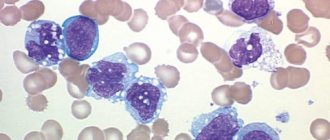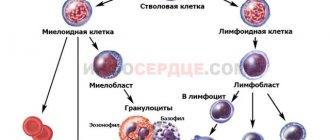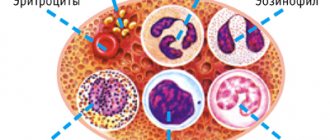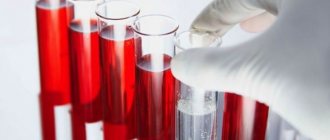Monocytes are synthesized in the bone marrow, from where they enter the systemic circulation, where they live for up to 3 days. Next, they will face either apoptosis (cell death programmed by nature), or improvement to the level of macrophages due to the growth of their internal structures - lysosomes and mitochondria. This improvement allows monocyte macrophages to more effectively perform their direct function - eliminating pathogenic microorganisms.
In addition to phagocytosis, monocytes perform several other useful functions:
- participate in allergic reactions, identifying foreign proteins;
- prevent the formation of malignant tumors;
- regulate the processes of hematopoiesis and coagulation (blood clotting);
- dissolve blood clots;
- help the body develop specific immunity to certain types of bacteria and viruses.
Blood test for monocytes
Figure 1. Leukocyte blood count.
Image: mikrostoker / Depositphotos A complete blood count is used to determine the level of monocytes. Typically, this study requires capillary blood (taken from a finger), but sometimes venous blood can also be used. In analysis forms, monocytes are also referred to as MON and MONO. Their normal content in the blood is 3-11%, and in absolute value - 0.04-0.08 * 109 / liter.
The normal level of monocytes in the blood does not depend on the gender of the patient. Pregnant women may experience a physiological increase in the number of monocytes, but this does not go beyond the normal range.
Causes of increased monocytes
Absolute monocytosis can develop in an adult in the following cases:
- For chronic intestinal diseases such as Crohn's disease, ulcerative colic, inflammation of the small intestine.
- Severe chronic diseases: rheumatoid or psoriatic arthritis, lupus erythematosus.
- Poisoning with substances containing: phosphorus, chlorine or their compounds.
- Infections with infectious diseases: brucellosis, syphilis, salmonellosis, tuberculosis, chickenpox, dysentery, rubella, influenza, whooping cough.
- Rheumatological diseases.
- Rheumatism, endocarditis.
- Blood diseases: chronic myeloid leukemia, osteomyelofibrosis, polycythemia, thrombocytopenic purpura, acute leukemia.
- The development of sepsis or the presence of purulent foci.
- Penetration of parasites and viruses into the body.
- Injury
- Malignant neoplasms of the lymphatic system: lymphoma, lymphogranulomatosis.
- Myocardial infarction.
- Development of fungal diseases.
Also, an excess of the norm of monocytes is observed in patients during the postoperative period and during the recovery period after infectious diseases. Lack of sleep, stress, a rich meal before taking the test, and excessive physical activity can cause an increase in monocytes. Therefore, it is necessary to take this data into account when taking the OAC.
In men
There are no specific reasons for increasing the level of monocytes in men. Men who often experience stress, work a lot, and work is closely related to mental stress and excessive nerves can suffer from monocytosis.
Among women
Elevated monocytes in a woman’s body indicate the presence of infectious diseases, as well as various inflammatory processes. The norms of leukocyte deviation do not depend on gender, however, in women, unlike men, monocytes can increase due to the characteristics of the reproductive system: during menstruation or ovulation, this is associated with a hormonal surge.
In pregnant women
During pregnancy and lactation, the level of leukocytes is especially important for a woman’s body. This is due to the fact that now the protective function must be performed not only for the matter, but also for the fetus inside it, and after the baby is born, they help the woman regain strength faster. During pregnancy, a restructuring of the immune and endocrine systems occurs in a woman’s body, and hormonal levels often change, so the ratio of all types of leukocytes changes.
The level of lower monocytes in the first trimester of pregnancy drops to 1%. But after just a few weeks it increases again to 3%, this figure remains until the last trimester, in which, due to changes in hormonal levels in connection with the body’s preparation for childbirth, the level of monocytes may increase. Immediately after childbirth, the level drops, but later rises again, which means that the body has begun to recover after childbirth.
In children
The normal levels of monocytes in the blood of children are higher than those of adults; the highest levels are observed in newborns. However, there is nothing to worry about if the age norms are not exceeded or the deviation level is not higher than 10%. An increase in this indicator may indicate the presence of infectious or viral diseases or infection with helminths. Often the reason for an increase in leukocyte levels can be the replacement of baby teeth with molars, this is associated with the formation of new tissues.
Also, an increase in monocytes may be associated with hereditary factors, the postoperative period and the presence of more severe diseases, for example, leukemia. It is worth noting that children often experience a low level of leukocytes (monocytopenia) than monocytosis; this is more dangerous and may indicate exhaustion of the body and weak resistance to harmful factors.
Indications for analysis
A general blood test to determine the leukocyte formula and monocyte level is prescribed to almost all patients who visit the clinic. The most common indications:
- viral or bacterial infections;
- oncological neoplasms;
- autoimmune diseases (Crohn's disease, rheumatoid arthritis, etc.);
- diseases of the circulatory system;
- helminthic infestations;
- inflammatory diseases of the kidneys, liver and any other organs;
- injuries, burns, frostbite.
Diagnostics
The level of monocytes is measured during the calculation of the leukocyte formula in a clinical blood test. Detection of monocytosis requires consultation with a medical specialist, preferably a therapist. The doctor must conduct a survey of the patient’s complaints, collect anamnestic data, and perform a general examination to identify signs of a particular disease. The data obtained serve as support for prescribing additional examination to determine the cause of monocytosis:
- Blood tests
. In a general blood test, the total number and percentage of all forms of leukocytes (leukocyte formula) are calculated, and the ESR is determined. The blood smear checks for the presence of atypical mononuclear cells. The level of autoantibodies (to DNA, muscle cells, topoisomerase), antigranulocyte antibodies, and CRP is examined. Immunohistochemical analysis and immunophenotyping of cells are performed to identify surface-specific or tumor CD markers. - Microbiological Research
. To identify the infectious pathogen, bacteriological culture and sputum microscopy are performed. The method of enzyme immunoassay and polymerase chain reaction determines antibodies to viruses, bacteria, and their DNA. Serological tests are carried out (indirect hemagglutination reactions, microprecipitation reactions). - Radiography
. In tuberculosis and sarcoidosis, X-rays of the lungs reveal an increase in the mediastinal and hilar lymph nodes; in histiocytosis, bilateral small-focal opacities are detected. Histiocytosis is also characterized by areas of osteolysis and destruction on radiographs of the flat bones of the skull and long tubular bones. - Sonography
. During ultrasound of the abdominal cavity in patients with infectious mononucleosis, brucellosis, and oncohematological diseases, splenomegaly and, less commonly, hepatomegaly are observed. Echocardiography in patients with collagenosis sometimes reveals thickening of the pericardial layers and effusion into the pericardial sac. - Histological studies
. In case of malignant blood diseases, a large number of blast cells are detected in a bone marrow smear obtained by sternal puncture or trepanobiopsy. Microscopic examination of bronchoalveolar fluid in patients with histiocytosis reveals giant Langerhans cells with eosinophilic cytoplasm. In a lymph node biopsy for lymphomas, proliferation of lymphoid cells and Berezovsky-Sternberg cells are detected.
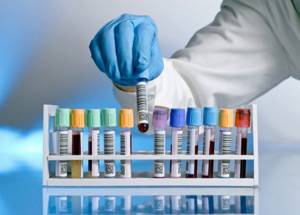
Laboratory diagnosis of monocytosis
Preparing for analysis
When preparing for a general blood test, you should follow just a few simple rules:
- take the test in the morning on an empty stomach;
- the day before the test, avoid heavy physical activity;
- Avoid alcohol, fatty and spicy foods for 2 days;
- On the day of the study, do not smoke and avoid nervous stress.
Refusal of physical activity is especially important on the day of the study, so it is advisable to avoid even fast walking and climbing stairs on the way to the clinic.
The normal level of monocytes in the blood
The level of monocytes in the blood depends on the patient's age. If we consider absolute values, that is, the content per liter of blood, then the norms look like this:
- Children under 12 years old: from 0.05 to 1.1 * 109 / liter.
- Children over 12 years old: from 0.04 to 0.08 * 109 / liter.
For convenience, fluctuations in percentages depending on age are given in the table.
Table 1. Normal monocyte levels in adults and children
| Age | Normal monocyte percentage |
| Newborns | 5 – 15% |
| Children from 2 weeks to one year | 4 – 10% |
| 1 – 2 years | 3 – 10% |
| 2 – 15 years | 3 – 9% |
| 16 years and older | 3 – 11% |
Causes of high levels of monocytes in the blood
An increase in the level of monocytes in the blood is called monocytosis. It is noted in the following cases:
- infectious diseases;
- acute and chronic inflammatory processes;
- helminthic infestations;
- recovery period after injury or surgery;
- oncological neoplasms;
- poisoning with toxic substances (including alcohol);
- autoimmune systemic diseases;
- diabetes.
Monocytosis can also be of a purely physiological nature. For example, monocyte levels increase within a few hours after eating. In women during menstruation, monocytosis is observed in response to the rejection of endometrial cells.
Figure 2. Monocytosis. Image: Leukemia Research Reports / ResearchGate (CC BY-NC-ND)
Causes of low monocytes
There are many reasons that lead to a decrease in monocyte levels. These could be viral infections, autoimmune diseases and even oncology. A sharp drop in their numbers is always observed in people undergoing chemotherapy, since chemotherapy drugs are aimed at suppressing the activity of the immune system.
Common reasons
Common reasons include:
- Burns and other severe injuries.
- Rehabilitation period after surgery.
- Cancer, cancer therapy.
- Chronic stress leads to constriction of the blood vessels supplying the bone marrow, which negatively affects the proliferation of all blood cells.
- Cushing's syndrome, in which the adrenal glands produce excessive amounts of hormones.
- Long-term therapy with glucocorticosteroids.
- Aplastic anemia, in which the bone marrow does not work properly.
- Inflammatory process in the body.
- Severe viral or bacterial infection.
- Physical exhaustion.
- Decreased immunity.
If the monocyte level approaches zero, there is a serious threat to life: the patient develops acute leukemia or sepsis. The body will not be able to cope with these diseases on its own.
In men
The following reasons lead to a decrease in monocyte levels in men:
- Stress.
- Therapy with cytostatics or corticosteroids.
- Starvation.
- HIV or developing AIDS.
- Bone marrow disorders.
- SCV.
- Intestinal inflammation.
- B12 deficiency anemia.
- Rheumatoid arthritis.
- Blood cancer.
- Epstein-Barr virus.
- Pain shock.
Among women
A drop in the level of monocytes in the blood of women is observed during pregnancy. This can be caused by decreased immunity or folic acid deficiency.
If the disease was detected in a woman who is not pregnant, she needs to consult a gynecologist. It is possible that the reason for the deviation in the tests is a sexually transmitted infection.
Causes of low levels of monocytes in the blood
A decrease in the level of monocytes in the blood below the age-appropriate norm is called monocytopenia.
Possible causes of low monocyte count:
- Aplastic anemia. This is a life-threatening condition that is caused by failure of the maturation of blood cells in the bone marrow.
- Oncohematological diseases. Late stages of leukemia are characterized by suppression of hematopoiesis, therefore, among other things, the number of monocytes in the blood decreases.
- Purulent bacterial infections. Such diseases include bacterial pneumonia, boils, cellulitis, and sepsis.
- Taking medications. Cytostatics and corticosteroids have the greatest effect in this regard.
Basic functions of monocytes
Increased level of monocytes in the blood
Monocytes are single-celled mature leukocytes, formed in the bone marrow, their life expectancy does not exceed three days. In the bloodstream they reach their most active state. Here they grow, function, and after about 70 hours they degenerate into macrophages, after which they penetrate into nearby tissues.
Protective and cleansing – this is their main function. Moving along the blood stream, they find foreign bodies such as cancer cells, infections, viruses, parasites and try to destroy them. To do this, the cell gets close to the detected problem, envelops it with its body, neutralizes it and removes it from the body. In the same way, monocytes destroy bacteria, dead cells and other substances that pollute the human body.
Macrophages act on the same principle, but they take longer to destroy harmful cells.
Monocytes also take part in the synthesis of interferon, which makes cells immune to the virus, thereby enhancing the body’s protective functions.
Thus, an increase in the content of monocytes means that there is a disease that the body is fighting hard against by increasing protective cells.
Consequences of deviation of monocytes from the norm
First of all, the reason for the deviation of monocytes from the age norm should be considered. If it is short-term stress, a heavy meal, pregnancy or menstruation, then there is no reason to worry. If the cause is infectious-inflammatory processes or other pathological conditions, then the lack of timely treatment can, at best, cause the disease to enter the chronic stage, and at worst, lead to death. In addition, an excess of monocytes in the blood itself can increase atherosclerosis, disrupt systemic blood flow and impair blood flow to the heart.
Why is an increase in monocytes dangerous?
An increase in monocytes in the body in most cases indicates the presence of pathology. When an infectious disease appears, the body begins a stubborn fight against it by additionally producing white cells to actively fight the disease. It seems that the more monocytes, the better, because this way you can quickly cope with the disease. In fact, there is a downside, since an excessive amount of them can itself provoke inflammation.
Large accumulations of white bodies in the vessels can:
- Disrupt blood flow.
- Strengthen atherosclerosis.
- Reduce blood flow to the heart muscle.
- Cause damage to the vessel wall.
How to reduce monocyte levels
The Mediterranean diet reduces the level of monocytes in the blood.
Photo: e_mikh / Depositphotos First, you should consult with your doctor, since the reasons for the increase in monocyte levels may be different, which means the treatment strategy will be different. Therefore, it is advisable to use all the tips below only with the approval of a specialist.
1. Physical activity. You can vary the degree of load depending on your exercise experience and health status. The most important thing is to practice regularly. Reducing triglyceride levels, normalizing body weight and increasing insulin sensitivity help lower the level of monocytes in the blood.
2. Consuming omega-3 fatty acids. They can be taken in the form of supplements, or can be obtained by eating foods high in omega-3 fatty acids (fish, caviar, flax seeds).
3. Fasting. Intermittent fasting reduces monocyte levels and improves metabolism, alleviating chronic diseases.
4. Mediterranean diet. It is recommended to consume lean meats and fish in moderation. The basis of the diet is yogurt, cheeses, vegetables, fruits, beans and whole grain bread. Moderate consumption of alcohol is allowed.
How to increase monocyte levels
A decrease in monocyte levels usually indicates a weakened immune system. Therefore, the main task in this case is to increase the body’s defenses. To do this, it is necessary to minimize bad habits, maintain a high level of physical activity, and also avoid lack of sleep and nervous stress.
It is also recommended to consume vitamins B12, C, D. They can be obtained with vitamin complexes or with food (meat, fish, eggs, milk, plums, cherries, rose hips, currants, garlic).
To increase the level of monocytes, you should significantly limit your alcohol consumption, or even better, give it up completely. Drinking alcohol provokes the so-called leaky gut effect: lipopolysaccharides from intestinal bacteria pass into the systemic bloodstream, as a result of which inflammatory processes develop in the body.
Quitting alcohol will help increase monocyte levels. Photo: AndreyPopov / Depositphotos
